It looks like you're using an Ad Blocker.
Please white-list or disable AboveTopSecret.com in your ad-blocking tool.
Thank you.
Some features of ATS will be disabled while you continue to use an ad-blocker.
share:
Oh and by the way - the nuclear crater is the OFFICIAL description. Yikes.
in that resto vid, it appears to be almost half of a baphomet, i can see it clearly although it is disguised to those with the blinders on. good vid
post!
Originally posted by harryhaller
This sculpture is vile, i'm sure you could spend days finding images within it's fold, all grotesque and twisted. Pure hate. Seeing those photo's of the poep's throne, i accept they are at least being honest about who they are.
This sculture will come alive, it is this that will speak. Don't know how i know this, but it will.
I'm already seeing skulls in it.. just to the left of Baphomets head, there's a row of them in an almost vertical column..
Maybe irt is, maybe it isn't.. just looks like it is and the suggestion alone is bad enough.
Originally posted by AfterInfinity
reply to post by Extralien
Baphomet is traditionally the god of wisdom and fertility. How is that evil? Has it occurred to anyone that the sculpture was designed to convey that impression? To keep impressionable minds under their spell?edit on 18-3-2013 by AfterInfinity because: (no reason given)
I happen to own the book by Eliphas Levi called "Trancendental Magic" where this image first appeared. People should look more into the occult and then realize that they're barking at the COMPLETELY wrong tree. Also, as creepy as the statue may be, it has nothing to do with Baphomet.
Satanic panic..
Hi ATS,
In the spirit of denying Ignorance I would like to provide a brief pictorial walk through of some of the sculptural works of artist Pericle Fazzini, the artist that made the bronze behind the Pope.
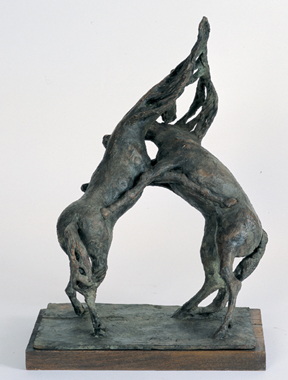
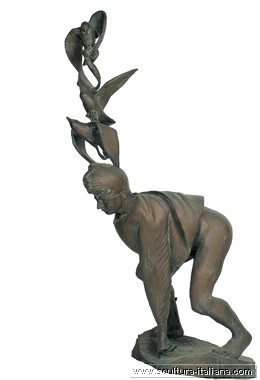
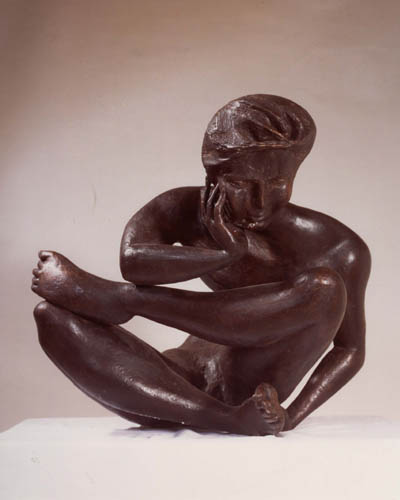
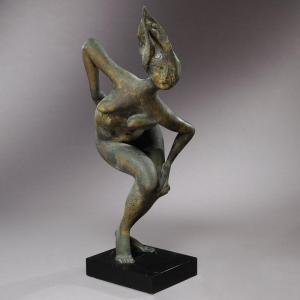

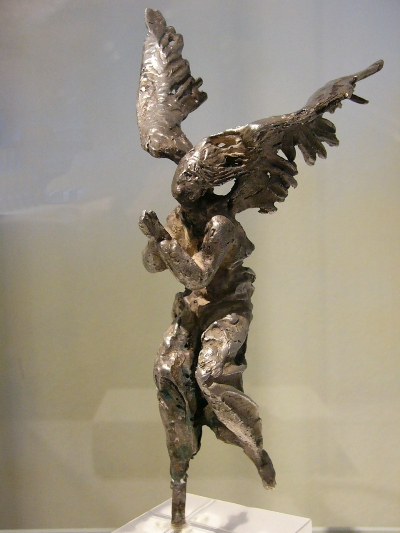
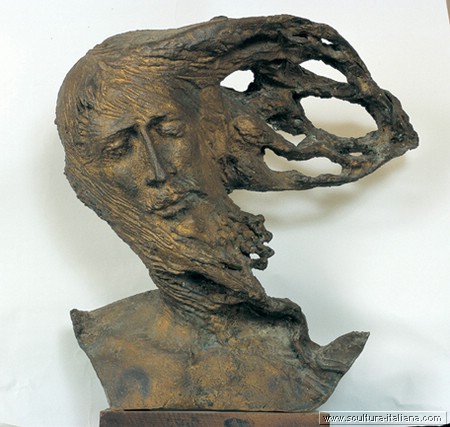
In the spirit of denying Ignorance I would like to provide a brief pictorial walk through of some of the sculptural works of artist Pericle Fazzini, the artist that made the bronze behind the Pope.
Something Is Up With Their Heads!
The Art of Pericle Fazzini







edit on 18-3-2013 by Bybyots because: bapho-madness
reply to post by Extralien
Heres an interesting video with a side view of the face and also the lighting amongst the sculpture.. Very disturbing to say the least.
Heres an interesting video with a side view of the face and also the lighting amongst the sculpture.. Very disturbing to say the least.
Looking at the photos, it looks to me like it could be baphomet or some other satanic-type beast, with a man coming out of his head, and many
"disembodied souls" or demons around him. Hard to tell perfectly from those pics, but that's kind of what I see.
Very interesting perspective. There are many things that cause us to see images where there really are none. We can even assign meanings and
connections to images that are not even really present.
That's nothing new, but that doesn't mean every time something is seen in a place where it shouldn't be that it's only a creation of our imagination.
Sometimes people forget to keep an open mind and plant their opinion firmly in one camp or the other, with no room for any other options. They point out that there is no way any hidden images are present, or there is no way the hidden images are random.
Personally, I don't see why there couldn't be hidden images and messages in something like what you are presenting... after-all, it is one of the most far reaching organizations on the planet and this event would be a perfect place to relay a message to all sects of their group.
Anyway, I always enjoy messing around with speculation like this, so I took a few minutes and screwed around in paint, this is what I came up with, please hold all applause for my 'World Class' artistic skills... ;

It's pretty obvious some of the things I thought about, but I want to explain the 'yellow circles' just a bit...
When I saw this picture, I was reminded of the soul collector type of character, seen in horror movies. The first one that comes to mind is the holiday comedy, 'Scrooged', starring Bill Murray.
I think it is the 'Ghost of Christmas Future' who wears the dark cloak, just as the 'Grim Reaper'. Bill Murray thinks it is an actor, in costume, for the show being produced by his character's studio. He opens the cloak and sees all the tortured souls in the 'Ghost of Christmas Future/Grim Reaper's' body, trying to escape.
I am sure you can probably think of several other instances where the tortured souls are shown trapped by a demonic creature.
Also, I'm not claiming any of the image I highlighted is fact. Just what my mind tries to see.
That's nothing new, but that doesn't mean every time something is seen in a place where it shouldn't be that it's only a creation of our imagination.
Sometimes people forget to keep an open mind and plant their opinion firmly in one camp or the other, with no room for any other options. They point out that there is no way any hidden images are present, or there is no way the hidden images are random.
Personally, I don't see why there couldn't be hidden images and messages in something like what you are presenting... after-all, it is one of the most far reaching organizations on the planet and this event would be a perfect place to relay a message to all sects of their group.
Anyway, I always enjoy messing around with speculation like this, so I took a few minutes and screwed around in paint, this is what I came up with, please hold all applause for my 'World Class' artistic skills... ;

It's pretty obvious some of the things I thought about, but I want to explain the 'yellow circles' just a bit...
When I saw this picture, I was reminded of the soul collector type of character, seen in horror movies. The first one that comes to mind is the holiday comedy, 'Scrooged', starring Bill Murray.
I think it is the 'Ghost of Christmas Future' who wears the dark cloak, just as the 'Grim Reaper'. Bill Murray thinks it is an actor, in costume, for the show being produced by his character's studio. He opens the cloak and sees all the tortured souls in the 'Ghost of Christmas Future/Grim Reaper's' body, trying to escape.
I am sure you can probably think of several other instances where the tortured souls are shown trapped by a demonic creature.
Also, I'm not claiming any of the image I highlighted is fact. Just what my mind tries to see.
Okay I want to point some things out with two clear pictures, as people have said before the sculpture that is called the Resurrezione is CLEARLY not
the same sculpture that was shown on TV.
And I read a comment here that the sculpture says its his lifeswork his masterpiece, so what are the chances he made two? And the last one seems bigger and more vile and you can almost feel the evil that is the church.
Sounds crazy and all but it almost looks like the statue grew over the years... turning more vile.. Bah In the first picture u see jezus and some branches.... No tormented souls no skulls... ( as members sayd before note the hands and even how the face is turning upwards whilst its now turning downwards....
The real Ressurezione

The new one
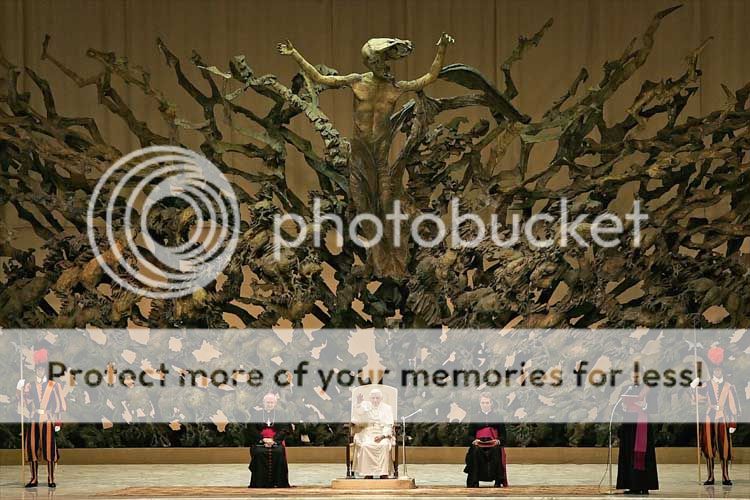
The one below I did a flip on
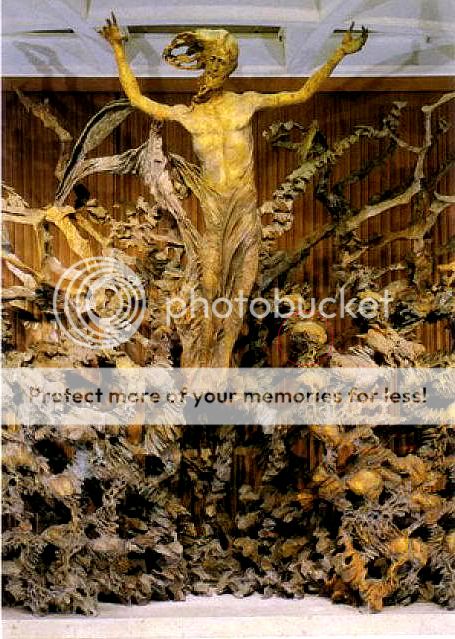
Edit: I flipped the old sculpture to view it from the same angle as the new one so you can see better the difference.
And I read a comment here that the sculpture says its his lifeswork his masterpiece, so what are the chances he made two? And the last one seems bigger and more vile and you can almost feel the evil that is the church.
Sounds crazy and all but it almost looks like the statue grew over the years... turning more vile.. Bah In the first picture u see jezus and some branches.... No tormented souls no skulls... ( as members sayd before note the hands and even how the face is turning upwards whilst its now turning downwards....
The real Ressurezione

The new one

The one below I did a flip on

Edit: I flipped the old sculpture to view it from the same angle as the new one so you can see better the difference.
edit on 18-3-2013 by
Senduko because: (no reason given)
edit on 18-3-2013 by Senduko because: (no reason given)
reply to post by Extralien
Wow man...I'm just speechless. I wasn't even finished reading your OP, and I could just see that 'thing' staring right at me. All I can see is the face of Baphomet.
This is not good on so many levels. The fact, that 'They' are getting more blatant with their occult symbolism is just getting outrageous. It's just everywhere lately.
I too, am also seeing the 'skulls' and 'twisted faces' through out the sculpture. I also get a very uneasy feeling from looking at this thing...just evil.
I have a feeling that the Jesus figure at the top of the sculpture with his 'hair flowing to his left side', is another form of symbolism to some degree, just not sure what.
Great post.
Edit: Ok, so I also just read the descripstion and wow...
Who in the right mind would let someone come up with this for a 'holy scultpure'. What is he implying here? That there is going to be a nuclear explosion in Jerusalem? It could also symbolize the rise of the anti-Christ by channeling negative and hateful energy through Baphomet Idol worship. "...vortex of violence and energy."...and Easter is just a few weeks away, the resurrection...
Wow man...I'm just speechless. I wasn't even finished reading your OP, and I could just see that 'thing' staring right at me. All I can see is the face of Baphomet.
This is not good on so many levels. The fact, that 'They' are getting more blatant with their occult symbolism is just getting outrageous. It's just everywhere lately.
I too, am also seeing the 'skulls' and 'twisted faces' through out the sculpture. I also get a very uneasy feeling from looking at this thing...just evil.
I have a feeling that the Jesus figure at the top of the sculpture with his 'hair flowing to his left side', is another form of symbolism to some degree, just not sure what.
Great post.
Edit: Ok, so I also just read the descripstion and wow...
''I had the idea of depicting Christ as if He were rising again from the explosion of this large olive grove, peaceful site of His last prayers. Christ rises from this crater torn open by a nuclear bomb; an atrocious explosion, a vortex of violence and energy.''
Who in the right mind would let someone come up with this for a 'holy scultpure'. What is he implying here? That there is going to be a nuclear explosion in Jerusalem? It could also symbolize the rise of the anti-Christ by channeling negative and hateful energy through Baphomet Idol worship. "...vortex of violence and energy."...and Easter is just a few weeks away, the resurrection...
edit on 18-3-2013 by ArchaicDesigns because: (no
reason given)
Why is Jesus head half-torn off?
I guess even the son of God isn't nuclear bomb-proof.
That is some creepy stuff. I can't imagine why the Vatican would want such a thing.
I guess even the son of God isn't nuclear bomb-proof.
That is some creepy stuff. I can't imagine why the Vatican would want such a thing.
reply to post by Senduko
The bottom picture you posted, ie, the new version of the statue is a flipped image.
The left has become the right..
just noticed it.
This similar pic was posted a lot earlier..gonna see if it's been flipped too..
Interesting if that is anofficial press release photo
The bottom picture you posted, ie, the new version of the statue is a flipped image.
The left has become the right..
just noticed it.
This similar pic was posted a lot earlier..gonna see if it's been flipped too..
Interesting if that is anofficial press release photo
reply to post by Extralien
I flipped it sorry, it was to be able to spot the differences better... Gonna add that in my post hehe But u see its clearly different.
I flipped it sorry, it was to be able to spot the differences better... Gonna add that in my post hehe But u see its clearly different.
reply to post by Bybyots
Looks like it depends, as do most things, upon the lighting. The poor light causes people to see things that aren't there just as they see shapes in clouds.
Looks like it depends, as do most things, upon the lighting. The poor light causes people to see things that aren't there just as they see shapes in clouds.
There is no reason that I can think of as to why a Catholic artist would not portray The Resurrected Christ as emerging from some morass
of chaotic shapes, as Fazzini has done in his sculpture. Remember, the work is called, The Resurrection.
The last place Jesus was, before he rose from the dead was Hades, scholars believe that it was modernized to read "Hell".
The Apostle's Creed
I believe in God,
the Father almighty,
Creator of heaven and earth,
and in Jesus Christ, his only Son, our Lord,
who was conceived by the Holy Spirit,
born of the Virgin Mary,
suffered under Pontius Pilate,
was crucified, died and was buried;
he descended into hell;
on the third day he rose again from the dead;
he ascended into heaven,
and is seated at the right hand of God the Father almighty;
from there he will come to judge the living and the dead.
I believe in the Holy Spirit,
the holy catholic Church,
the communion of saints,
the forgiveness of sins,
the resurrection of the body,
and life everlasting. Amen.
en.wikipedia.org...
The last place Jesus was, before he rose from the dead was Hades, scholars believe that it was modernized to read "Hell".
edit on 18-3-2013 by Bybyots because: .
I don't think it is a baphomet, but it's still a twisted, dark looking sculpture for the pope to sit in front of. It almost looks like it's from a
horror movie or something. Then again, this is the church with leaders that think child rape is good fun. It would not surprise me if the higher ups
are illuminati or part of some other dark cult.
The Vatican commissioned Mr. Fazzini to provide a work for its modern auditorium. The result was ''The Resurrection,'' a statue depicting Jesus rising from a nuclear bomb crater.
''Suddenly there came to me the idea of Christ preaching peace for 2,000 years, and the place where He prayed for the last time: the olive grove of Gethsemane,'' said Mr. Fazzini in a book about the work. ''I had the idea of depicting Christ as if He were rising again from the explosion of this large olive grove, peaceful site of His last prayers. Christ rises from this crater torn open by a nuclear bomb; an atrocious explosion, a vortex of violence and energy.''
Oh no.
If this means what I think it means, there is a strong possibility that these people plan on bringing out the Antichrist AFTER a nuclear bomb goes off.
Originally posted by Bybyots
edit on 18-3-2013 by Bybyots because: bapho-madness
And that picture clearly details a wound to the head by means of another explosion of some sort.
Originally posted by Bybyots
There is no reason that I can think of as to why a Catholic artist would not portray The Resurrected Christ as emerging from some morass of chaotic shapes, as Fazzini has done in his sculpture. Remember, the work is called, The Resurrection.
The Apostle's Creed
I believe in God,
the Father almighty,
Creator of heaven and earth,
and in Jesus Christ, his only Son, our Lord,
who was conceived by the Holy Spirit,
born of the Virgin Mary,
suffered under Pontius Pilate,
was crucified, died and was buried;
he descended into hell;
on the third day he rose again from the dead;
he ascended into heaven,
and is seated at the right hand of God the Father almighty;
from there he will come to judge the living and the dead.
I believe in the Holy Spirit,
the holy catholic Church,
the communion of saints,
the forgiveness of sins,
the resurrection of the body,
and life everlasting. Amen.
en.wikipedia.org...
The last place Jesus was, before he rose from the dead was Hades, scholars believe that it was modernized to read "Hell".
edit on 18-3-2013 by Bybyots because: .
And there was me thinking he was in a sealed cave when he was ressurected..
I'm sure someone once told me that..
This is the very first I've ever heard of him having to go to hell (hades) first.
But if he was in Hades, then this Christian religion had some basis in the ancient Greek beliefs;
Hades (pron.: /ˈheɪdiːz/; from Greek ᾍδης (older form Ἀϝίδης), Hadēs, originally Ἅιδης, Haidēs or Άΐδης, Aidēs (Doric Ἀΐδας Aidas), meaning "the unseen"[1]) was the ancient Greek god of the underworld. The genitive ᾍδου, Haidou, was an elision to denote locality: "[the house/dominion] of Hades". Eventually, the nominative came to designate the abode of the dead. In Greek mythology, Hades is the oldest male child of Cronus and Rhea. According to myth, he and his brothers Zeus and Poseidon defeated the Titans and claimed rulership over the cosmos, ruling the underworld, air, and sea, respectively; the solid earth, long the province of Gaia, was available to all three concurrently.
en.wikipedia.org...
So which is it? greek mythology or Christian 'knowledge'?
Buyt before anyone bites my head off.. there does appear to be a very soft link to this Hades place.. yet this linkstill comes from the Greek but seems to have been mixed up and dragged kicking and screaming into the present day knowledge as some kind of fact..
Hades is the standard translation for Sheol in the Septuagint, Josephus, Philo of Alexandria, and other Jewish works written in Greek.
In the Greek version of an obscure Judaeo-Christian work known as 3 Baruch (never considered canonical by any known group), "Hades" is described as a dark, serpent-like monster or dragon who drinks a cubit of water from the sea every day, and is 200 plethra (20,200 English feet, or nearly four miles) in length.
Like other first-century Jews literate in Greek, early Christians used the Greek word Hades to translate the Hebrew word Sheol. Thus, in Acts 2:27, the Hebrew phrase in Psalm 16:10 appears in the form: "you will not abandon my soul to Hades." Death and Hades are repeatedly associated in the Book of Revelation.[23]
The New Testament uses the Greek word Hades to refer to the temporary abode of the dead (e.g., Acts 2:31; Revelation 20:13).[24] Only one passage describes hades as a place of torment, the story of Lazarus and Dives.[Luke 16:19-31] Here, Jesus depicts a wicked man suffering fiery torment in hades, which is contrasted with the bosom of Abraham, and explains that it is impossible to cross over from one location to the other. Some scholars believe that this parable reflects the intertestamental Jewish view of hades (or sheol) as containing separate divisions for the wicked and righteous.[24][25] In Revelation 20:13-14 hades is itself thrown into the "lake of fire" after being emptied of the dead.
So a Jewish-Greek combination gave way to a Christian system.. Seeing as none of them seem to know for sure, it's all just a great story.
new topics
-
D.B. Cooper mystery may be solved
General Conspiracies: 56 minutes ago
top topics
-
D.B. Cooper mystery may be solved
General Conspiracies: 56 minutes ago, 4 flags
active topics
-
Petition Calling for General Election at 564,016 and rising Fast
Political Issues • 97 • : BrucellaOrchitis -
D.B. Cooper mystery may be solved
General Conspiracies • 3 • : Shoshanna -
I thought Trump was the existential threat?
World War Three • 81 • : network dude -
Joe Biden Dabs Away Tears at Farewell White House Dinner
Politicians & People • 27 • : chr0naut -
Results of the use of the Oreshnik missile system in Dnepropetrovsk
World War Three • 241 • : andy06shake -
Why isn't Psychiatry involved?
Social Issues and Civil Unrest • 14 • : BrucellaOrchitis -
Well, here we go red lines crossed Biden gives the go ahead to use long range missiles
World War Three • 396 • : andy06shake -
-@TH3WH17ERABB17- -Q- ---TIME TO SHOW THE WORLD--- -Part- --44--
Dissecting Disinformation • 3384 • : brewtiger123 -
BIDEN Admin Begins Planning For January 2025 Transition to a New President - Today is 4.26.2024.
2024 Elections • 59 • : WeMustCare -
DOJ Special Counsel Robert HUR Says JOE BIDEN Can Be ARRESTED After Jan 20th 2025.
Above Politics • 30 • : WeMustCare
